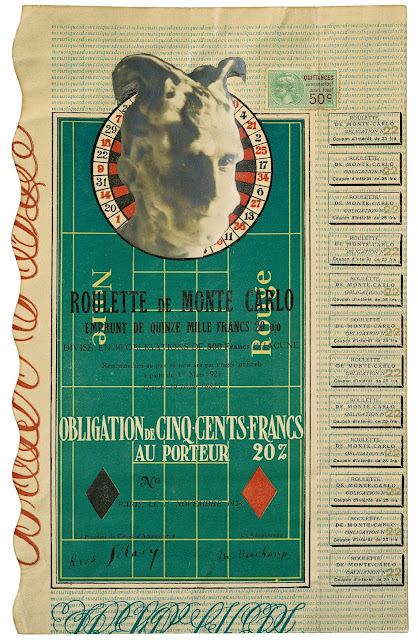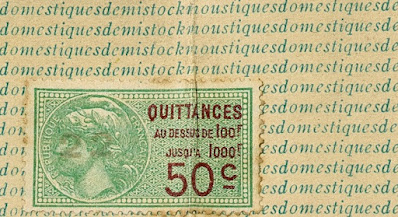Recently I was surprised by a vintage stock certificate. Its design was rather plain featuring an eagle vignette, frequently seen on American scripophily. But the name of the issuing company was SPACETRONICS, INC., and that was enough to get my attention.
My first guess was that the company developed radar equipment, missile guidance systems or something like that. But that turned out not to be the case.
This story is about Walter A. Crowley (1917-2008). As an engineer he worked at General Motors, and later at Chrysler on guidance systems for missiles. Crowley also designed and built a Benson Gyrocopter but after two crashes he aimed his research at 'flight without height'.
Crowley observed that blowing air into the center of a conical lampshade would cause it to rise and hover steadily above any surface, including water. In 1957 he developed an air cushion vehicle that could traverse land or sea without physical contact.
A first test flight, or you could say test ride, occured in an in-house experiment with Crowley's ten year old son as the test pilot. Other prototype vehicles and outdoor tests followed. In the mean time he formed his Hydro-Air Transportation Company and filed a patent in 1958.
In this period Carl W. Bollum Sr. worked at the Washington office of the Army Ballistic Missiles Agency. Bollum was sent out to learn about Crowley's ideas. But, unlike himself, his office did not show further interest.
Soon after Bollum left the army he founded Spacetronics. The company incorporated on October 8, 1958, under the laws of the District of Columbia. Spacetronics was located at Bethesda, Maryland, less than 10 miles away from Washington, D.C. Bollum was chairman of the board and president.
Spacetronics acquired Crowley's company and its related patents and rights. In return Bollum promised to provide capital to develop Crowley's ideas. He hired Crowley as chief engineer and appointed him vice president.
In that period the US Navy got interested in the so-called "ground-cushion phenomenon". Hearings sessions took place before the Committee on Science and Astronautics at the House of Representatives on 13, 14 and 15 April, 1959. Several projects on air cushion vehicles were discussed. The key people from Spacetronics were invited to present their developments. Other projects screened involved those from the Ford Motor Company and the Curtiss-Wright Corporation, among others.
At the start of the hearings, Admiral R. Bennett, Chief of Naval Research, USN, explained why the Navy and the Marine Corps was interested :
"... such a ground proximity machine, used as an amphibious transport or an assault boat, with a low silhouette and moderate load-lifting capability would be extremely valuable in accelerating the ship-to-shore movement. Traveling 4 or 5 feet over the wave tops at speeds up top 50 mph and capable of negotiating beaches up to 15 percent slope, the vehicle would present a far less vulnerable target than our present craft ..."
Bollum, president of Spacetronics, knew how lucrative military contracts could be. His company built a heavy-duty prototype vehicle for the US Marine Corps. The machine could achieve a ground clearance of nearly 12 inches and was stable even as a dozen men moved around its deck.

This Hydro-Air vehicle, aka a ground effect machine, built by Spacetronics, Inc., is designed for traversing swampy ground, snow or ice. A flexible skirt enables it to cross many obstructions. The horizontal propeller behind the driver maintains pressure in the hollow body.
The company gets national coverage after The New York Times, on Sunday, October 11, 1959, publishes a special news article "Flying Platform Planned in U.S." :
A Washington concern announced last week that it was building a flying platform as a prototype for a cargo-carrying craft that would skim over water on an air cushion. The "Hydro-Air" vehicle, being built by Spacetronics, Inc., is similar to the Saunders-Roe Hovercraft that is under test in Britain. The American craft is scheduled to be unveiled next month.
When completed, the prototype will be tear-drop shaped, thirty-two feet long, twenty-four feet wide and two feet high. A horizontal propeller at the forward section will pump air downward to lift the craft just off the water. With aft-mounted fans, for forward propulsion, the vehicle will attain speeds up to fifty miles an hour, it was said.
Officials reported that there were essentially two designs for providing lift for such a vehicle. One is a "pelum chamber" [sic; should be 'plenum chamber' ], used on the Spacetronics craft, to provide a billowing volume of air, and the other "annular jets which gain lift by directing a curtain of air at the water surface", he said. The latter is the method used on the Saunders-Roe craft.
Around the same time the British worked on a much larger commercial vehicle, the "hovercraft, based on the earlier work by Christopher Cockerell and produced by the Sanders-Roe company.
Both Cockerell's and Crowley's prototypes could not spark more military interest. Two main problems of these early crafts were inaccurate steering control and the stirring up of dust on land.
In 1960 the Spacetronics owners moved to Daytona Beach, Florida, with the intention to produce a commercial-type model for fishermen.
They had some big ideas. In The International Teamster (a union magazine), issue Oct 1960, you can read that the company was designing a big cargo air truck. Allegedly Southern Airways, Inc., had ordered two of these from Spacetronics, envisioning trucking cargo over water on regular scheduled runs between Miami and the Bahama Islands.
Another far reaching idea from Spacetronics shows a train riding air cushions on a concrete rail
source: Popular Mechanics 1960-06: Volume 113, Issue 6, via the Internet Archive
It is not clear what happened next, but the company was suddenly dissolved. Yet, Bollum still believed in the potential of Crowley's ideas. You can see
here that in 1963 Bollum filed a patent for an "earth-skimming air vehicle" mentioning his name as the inventor.
Walter A. Crowley went to develop new air cushion concepts at American Machine and Foundry in Stamford, Connecticut. In 1961 the Boeing Company hired him. There he developed an air-bearing system for moving heavy objects with compressed air, up to and including an entire 747 Jumbo Jet. In fact, in 1967, Boeing spun off a succesful subsidiary, Aero-Go, to commercialize all kinds of products based on Crowley's concepts : aero-planks, aero-pallets, air-cushion vehicles, scissor lift tables and much more.
Crowley's original scale model and prototype hovercraft is on display in the Smithsonian Air Museum in Washington, D.C.
Walter A. Crowley, research & development manager of Aero-Go, demonstrates the Terra Skipper while skimming over sand and sea at 30 miles an hour.
Excerpt from The Seattle Times, Pictorial, November 24, 1968 as seen on aerogoeurope.de 8 Nov 2021
F.L.
Something extra :
- The Spacetronics, Inc., share illustrated here was issued to James Harold Scribner. Likely, this is Dr. James Harold Scribner, the first US Navy dentist to visit the South Pole and Antarctica. He participated in the first Operation Deep Freeze in 1955-56 with Admiral Byrd. Spacetronics was involved as a Navy contractor, and in the hearings sessions of 1959 (see main article) the company envisioned its air cushion vehicles operating also in polar regions. The company's location was Bethesda, MD, where there was a dental clinic at the Bethesda Naval Hospital. From a good source I learned that Dr. Scribner was married to Dorothy Louise Scribner nee Meadows who worked as a navy nurse stationed at Bethesda!
Reference links :










































